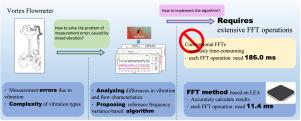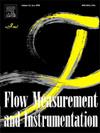Reference frequency variance-based rapid identification method for vortex flow rate under mixed vibration interference
IF 2.3
3区 工程技术
Q2 ENGINEERING, MECHANICAL
引用次数: 0
Abstract
Pipeline systems in industrial applications may encounter strong mixed vibration interference, resulting in measurement errors of vortex flowmeters. Current research primarily addresses single types of vibration interference. Various signals output by vortex flow sensors under diverse operating conditions were analyzed to tackle the issue of mixed vibration interference. The amplitude and frequency characteristics of transient impact-type interferences were studied. The differences in frequency fluctuations between periodic interferences and periodic signals were investigated. Then, a method based on reference frequency variance was proposed to resist mixed vibration interference. The primary calculation load of this method arises from the execution of Fast Fourier Transform (FFT). To meet the instrument requirements of low-power consumption and real-time performance, a multipoint FFT method based on a low-power accelerator built-in microcontroller was proposed, which remarkably improved the calculation speed of multipoint FFT and conserved storage space. The reference frequency variance-based antimixed vibration interference algorithm was implemented in real time using a low-power vortex flowmeter system developed by our team, and an antimixed vibration interference gas flow verification experiment was conducted. The method can accurately identify vortex flow signals when the interference energy of the periodic type and the main mode energy of the transient impact surpasses the energy of the flow signal.

基于参考频率方差的混合振动干扰下涡流流速快速识别方法
工业应用中的管道系统可能会遇到强烈的混合振动干扰,从而导致涡街流量计出现测量误差。目前的研究主要针对单一类型的振动干扰。为了解决混合振动干扰问题,我们分析了涡街流量传感器在不同工作条件下输出的各种信号。研究了瞬态冲击型干扰的振幅和频率特性。研究了周期性干扰和周期性信号之间频率波动的差异。然后,提出了一种基于参考频率方差的方法来抵抗混合振动干扰。这种方法的主要计算负荷来自于快速傅立叶变换(FFT)的执行。为满足仪器对低功耗和实时性的要求,提出了一种基于内置微控制器的低功耗加速器的多点 FFT 方法,显著提高了多点 FFT 的计算速度,并节省了存储空间。利用本团队研制的低功耗涡街流量计系统,实时实现了基于参考频率方差的抗混频振动干扰算法,并进行了抗混频振动干扰气体流量验证实验。当周期型干扰能量和瞬态冲击主模能量超过流量信号能量时,该方法能准确识别涡流信号。
本文章由计算机程序翻译,如有差异,请以英文原文为准。
求助全文
约1分钟内获得全文
求助全文
来源期刊

Flow Measurement and Instrumentation
工程技术-工程:机械
CiteScore
4.30
自引率
13.60%
发文量
123
审稿时长
6 months
期刊介绍:
Flow Measurement and Instrumentation is dedicated to disseminating the latest research results on all aspects of flow measurement, in both closed conduits and open channels. The design of flow measurement systems involves a wide variety of multidisciplinary activities including modelling the flow sensor, the fluid flow and the sensor/fluid interactions through the use of computation techniques; the development of advanced transducer systems and their associated signal processing and the laboratory and field assessment of the overall system under ideal and disturbed conditions.
FMI is the essential forum for critical information exchange, and contributions are particularly encouraged in the following areas of interest:
Modelling: the application of mathematical and computational modelling to the interaction of fluid dynamics with flowmeters, including flowmeter behaviour, improved flowmeter design and installation problems. Application of CAD/CAE techniques to flowmeter modelling are eligible.
Design and development: the detailed design of the flowmeter head and/or signal processing aspects of novel flowmeters. Emphasis is given to papers identifying new sensor configurations, multisensor flow measurement systems, non-intrusive flow metering techniques and the application of microelectronic techniques in smart or intelligent systems.
Calibration techniques: including descriptions of new or existing calibration facilities and techniques, calibration data from different flowmeter types, and calibration intercomparison data from different laboratories.
Installation effect data: dealing with the effects of non-ideal flow conditions on flowmeters. Papers combining a theoretical understanding of flowmeter behaviour with experimental work are particularly welcome.
 求助内容:
求助内容: 应助结果提醒方式:
应助结果提醒方式:


